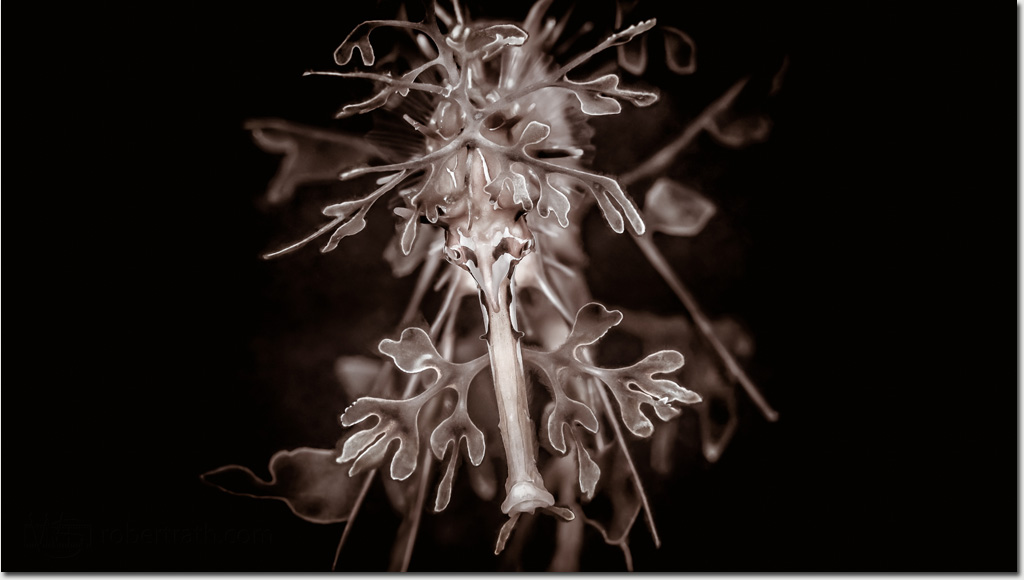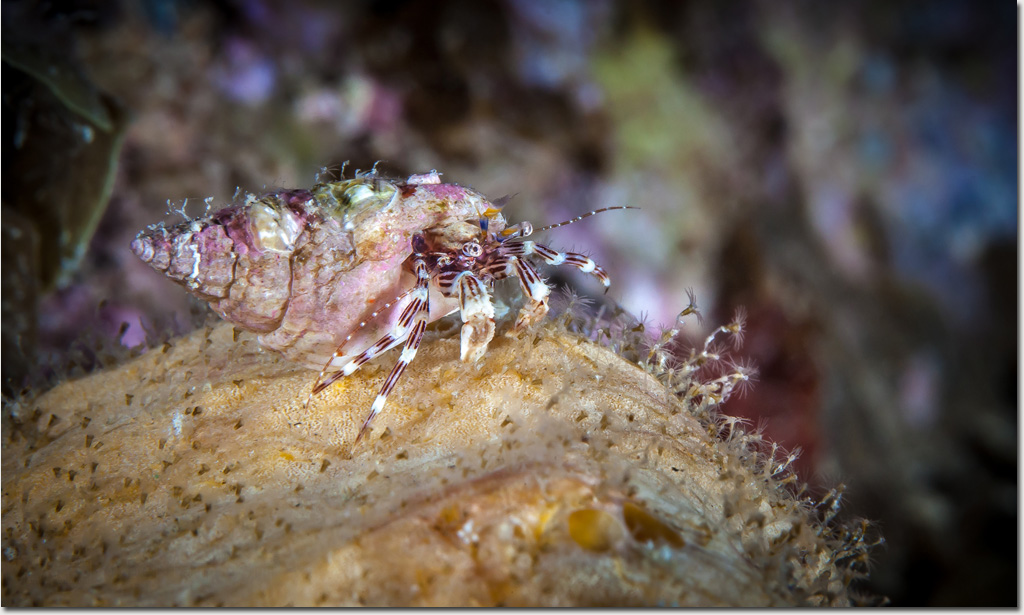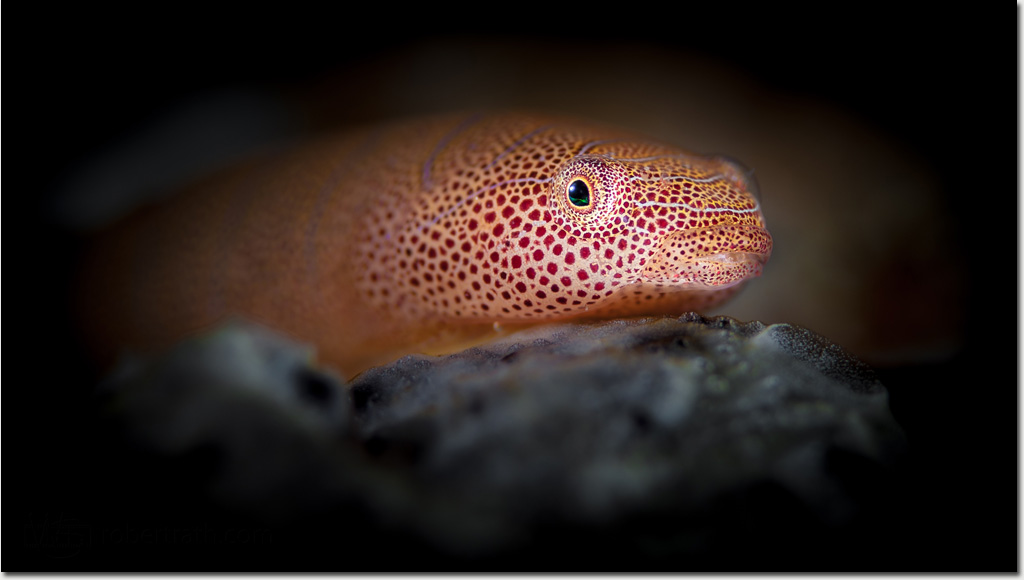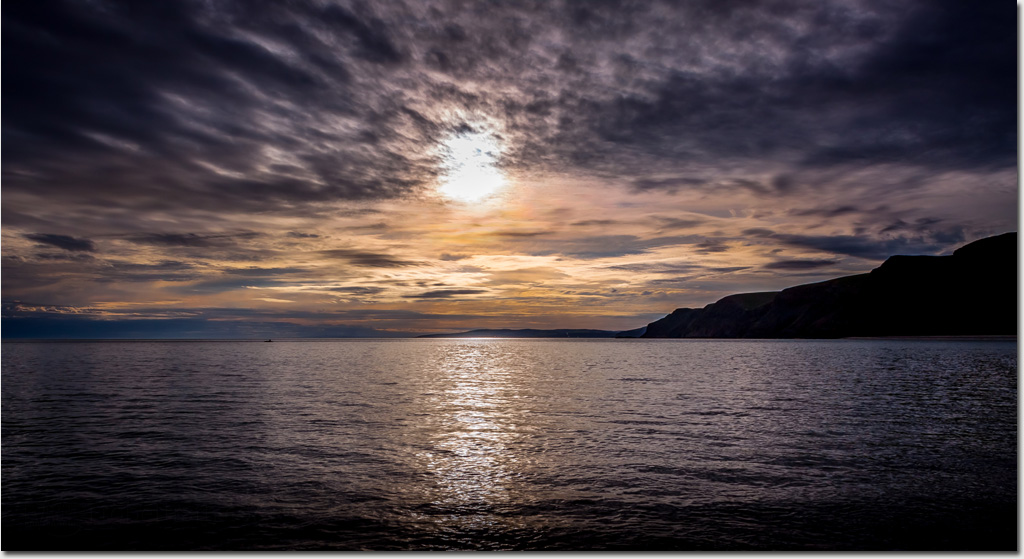Quicksearch
Your search for rapid returned 116 results:
Wednesday, September 14. 2016

Like a tribal decoration, elegant, ornate and with a geometry only nature could devise you hang there in the evening gloom of a dark and cold sea.
Oh so patient with your paparazzi fan, lilting this way and that way you tease me. Some times eager to show your best side and sometimes not wanting to be seen from any side.
Despite your generosity, having had enough of my terrestrial intrusion, gently you drift back into the algae and the sea-grasses to once more resemble nothing more than their gently sway back and forth on the ocean floor.
Leafy seadragon, Phycodurus eques, Rapid Bay
Photo: Robert Rath, 'Tribal Decoration' 1/160s f/13 ISO320 100mm
Monday, June 20. 2016

It was not meant to be a Rapid Bay night dive. It was not even meant to be a dusk dive but in the end it was a race against the light.
As our days are as short as they will be for the year it is easy to get caught out not planning an afternoon dive early enough to beat the sunset.
I remember looking up at the dappling yellow and greens of the sunset above us and we still had not found any leafy seadragons.
Then as the undersea gloom of dusk descended we found them and to our delight we found an entire family, two adults and one juvenile.
For the next 20 minutes we played in the gloom until it was too dark to focus and it was too cold to bare.
It was never the plan but in the end it was wonderful to experience the leafy's at dusk as the gloom engulfed us.
Photo: Robert Rath, 'Dusk Dragons', 1/60s f/10 ISO800 15mm
Monday, June 13. 2016

Back in the water, it's dropped to a chilly 15 degrees and will be heading further down from there through winter and into spring.
Despite the cold it is good to be diving again after too long on dry land and it was great to see all the usual undersea suspects again including this red sea star, Pentagonaster dubeni, on its way up this pylon to bigger and better things no doubt. A real rising star!
Rapid Bay is one of those special places that we are so fortunate to have so close to home. Sometimes I take for granted just how easy it is to drive, park and dive and grumble about how heavy my weight belt is for the short walk from car to water. Underwater though I feel nothing but privileged and gratitude to share a place human are just not supposed to be. At least not for very long anyway.
My dives will be a little shorter than usual with the cold water and my old wetsuit but the cold wont keep me away. Perhaps next dive I'll find just how far that sea star got.
Photo: Robert Rath, 'Rising Star', 1/125s f/10 ISO800 15mm
Tuesday, April 26. 2016

There is always a school or two ... or three of Yellowtail Scad ( Trachurus novaezelandiae) cruising in and around the pylons under the old Rapid Bay Jetty.
Not so common is to find them out on the adjacent seagrass beds. It must schoolies week for Yellowtail Scad.
Photo: Robert Rath, 'Schoolies', 1/160s f/8 ISO160 15mm

What's pink and fluffy and tastes great?
The pink spongy mass might look like fairy-floss but that's where the similarity ends, unless of course you are a nudibranch.
This is the first time I have found this species of nudibranch, Ceratosoma brevicaudatum, eating this particular species of sponge. Perhaps that's where it gets its pink spots from!
In this image I have used an imaging style called 'close-focus wide-angle'. Unlike most CFWA images however I have chosen to shoot wide open giving an unusually narrow depth of field for this style.
CFWA is often used to portray a subject in its larger environment however by also using a wide aperture I have separated foreground and background and created a portrait feel.
So back to the nudibranch and its spongy pink lunch on a Rapid Bay jetty pylon, I'm fairly certain it tastes nothing like fairy-floss. Though to a nudibranch, maybe it does!
Photo: Robert Rath, 'Nudi Fairyfloss', 1/160s f/2.8 ISO160 15mm
Wednesday, March 30. 2016

This forest is like non other. It's enchanted.
Take a stroll though any old forest anywhere else and the birds fly out of reach, the rodents hide out of sight while the larger animals just run away.
Take a swim through this forest though and it's like animal wonderland. Fish fly like birds and butterflies around the trunks from ground to canopy.
Larger fish cruise through the scene at eye level keeping no more than an arms length out of reach.
Still larger animals like sharks and rays wander through occasionally, wary but making no attempt to hide as they go about their business.
Every touchable surface from bottom to sky is teaming with animal life such as sponges, crabs, sea stars, ascidians and invertebrates.
This enchanted place under the old Rapid Bay Jetty is my kind of forest.
Photo: Robert Rath, 'Enchanted Forest' 1/125 f/9 ISO640 15mm
Monday, March 28. 2016

With the festive break over it's back to non-photographic endeavors but at least I got to dive with this guy today to cap it off on a wonderful note.
I usually see at least one Leafy Seadragon when I dive at Rapid Bay however for a while it looked like we might miss out today.
We had traversed the outer T-section following the seagrass beds looking for pipefish and seadragons. The pipefish were abundant but no seadragons were found anywhere.
Down to a fraction of our air remaining we swam to a known dragon lair and there he was, a big male still covered in a fine film of green algae left over from his last brood of eggs.
Time to start looking for little dragons!
Photo: Robert Rath, 'Easter Leafy' 1/200s f/9 ISO640 15mm
Sunday, March 20. 2016

Our Rapid Bay night dive was meant to be about little critters, especially nudibranchs smaller than half my little finder but when this Southern Calamari (Sepioteuthis australis) came into my view I was suitably distracted.
In fact I was so distracted in the strong current that I had drifted 70m or more from the jetty pylons out into seagrass beds.
The amazing coloration of squids is due to the chromatophres in their skin giving them an almost electric vibrance at night,
After a handful of mid-water shots I eventually headed back to the jetty pushing directly into into the strong current for my navigation.
I saw a couple more squid during the dive but none posed for me the way this guy did.
Photo: Robert Rath, 'Electric Squid' 1/100s f/22 ISO400 100mm
Friday, March 18. 2016

In the past I had described photographing hermit crabs as ‘low hanging fruit’ but this guy was not so easy.
Clarrie's Hermit Crab (Pagurixus handrecki) here under Rapid Bay Jetty is tiny, about the size of my little fingernail and was marching furiously around the top of its own private little hill.
Despite the diminutive size it looked so busy and so full of pride that I nearly missed the moment when it reached the top before starting back down the other side.
Photo: Robert Rath, ‘Top of the Hill’, 1/100s f22 ISO400 100mm
Thursday, December 10. 2015

Who's following who here I wonder as this school of Zebra Fish ( Girella zebra) cruise through the pylons of Rapid Bay Jetty.
These fish are mostly juveniles but near the front of the school there are a few adults who seem to have things in hand leading the young ones from pylon to pylon.
On some pylons they feed and make a real mess. On other pylons they seem to just want to rub themselves up and down.
Then they are off following each other again.
Photo: Robert Rath, 'Follow Me', 1/500s f/8 ISO400 15mm
Sunday, November 29. 2015

Dive the shallows of the old Rapid Bay Jetty at the moment and you can expect to be stalked.
This school of Zebra Fish (Girella zebra) started following me around as I searched the general area for other critters. Soon I was so caught up in their antics and carry on that they had me for the rest of my dive.
I'd follow them and then they would follow me. At times I found myself in the middle of the school and then they would break away out into open water only to loop around in big circle to come up behind me again.
Every dive at Rapid Bay is special and this dive the Zebra Fish made it magical.
Photo: Robert Rath, 'Zebra Crossing II', 1/400s f/8 ISO160 15mm
Tuesday, November 24. 2015

I am not sure which location I prefer for Leafy Seadragons, The Bluff or Rapid Bay.
Rapid Bay has an incredible diversity of sea life and never disappoints even if I do not see the critters I have come to photograph. It is a safe bet for a great dive even when the conditions are not so good.
The Bluff on the other hand is rough, has poor visibility, is exposed to southern swells but I never fail to find Leafys here. Even though this dive does not have the variety of life the Rapid Bay offers it has a rugged oceanic appeal that makes me come back time and time again for the Leafys of course but also for the great granite bombies, the thick kelp, seals, crays and of course the usual suspects (a technical term for local South Australian reef fishes).
This Leafy Seadragon ( Phycodurus eques) is being swept back and forth through the kelp and around boulders but doesn't seem to mind at all. This is typical of their environment here and is what makes this dive so appealing.
Photo: Robert Rath, 'Dragon Alley' 1/200s f/3.5 ISO100 15mm
Monday, November 23. 2015

This Leafy Seadragon headshot was taken during a recent daytime dive at Rapid Bay.
This is another example of extreme separation normally associated with a night shot but instead done through strong strobes and removal of the blue luminance.
I expect he'll be wearing dark sunglasses next time I return.
Photo: Robert Rath, 'Headshot', 1/200s f/8 ISO100 100mm
Wednesday, November 18. 2015

Imagine for a moment that going to heaven for a fish might have something to do with that strange sunlit world above?
Twenty years ago, 'up there', would have been teaming with amateur fishers angling for a piece of undersea action. From the fishes perspective the last place they might wish to go.
For years now Rapid Bay jetty has been slowing collapsing into the ocean. No one sets foot on its structure anymore. Sections of the Jetty are completely gone and no more fishing lines descend from above.
Where once were fishers there are now gulls and cormorants and of course fresh air.
For the fishes heaven will never be 'up there', only death.
Photo: Robert Rath, 'Heavens Above' 1/50s f/8 ISO160 15mm
Tuesday, November 17. 2015
 Sepia apama
Sepia apama, the Giant Cuttlefish, is the largest of the cuttlefish and a South Australian draw-card critter. Thousands of cuttlefish congregate to mate in the shallows at the top of Spencer Gulf each winter creating amazing opportunities for divers and snorkelers to observe their antics in only metres of water.
This guy however lives out in the seagrass near Rapid Bay jetty where there was evidence enough he was up to antics of his own.
Photo: Robert Rath, 'The Giant Cuttlefish' 1/200s f/8 ISO160 15mm
Sunday, November 15. 2015

I may be looking up towards the light but that's of no use when it comes to lighting the way. I bring my own.
Conditions at Rapid Bay were sensational yet again with more schooling behavior under the 'Tee' than I have seen for a very long time.
As I arrive at the site I pulled up next a group of very happy divers who were laughing, whooping and exclaiming how exciting it was finally become certified open water divers.
I did not realise it then but later as I swam though forests of schooling scad, marveled at the visibility and was captivated by the dappled sunlight on the sand I realised just how special a dive those brand new divers just experienced.
I hope the conditions did not spoil them as South Australian diving ranges from sublime to ugly depending on the day.
This one was particularly good!
Photo: Robert Rath, 'Towards The Light' 1/40s f/8 ISO160 15mm
Friday, November 13. 2015

This poor guy is suffering war wounds of love as he and many other suitors battle it out for the available girls.
There seems to be a lot of cuttlefish activity at the moment with both males and females engaging in all sorts of games.
If you look closely here you will notice translucent lumps all over his body where other males have taken chunks. The translucent colour is due to the lack of chromatophores in the wounded area.
He's fairing pretty well I'd say and will be up for a lot more before the season is over.
Giant Cuttlefish, ( Sepia apama), Rapid Bay, South Australia
Photo: Robert Rath, 'Wounded One' 1/100s f/8.0 ISO160 50mm
Tuesday, November 10. 2015

Most divers at Rapid Bay perform the usual ritual of crossing the sand from the new jetty to the old before really starting to pay attention to their surroundings.
Granted, the old jetty is certainly the draw card here but take the time instead to head off in a different direction, over the seagrass beds and it is an entirely different experience.
The seagrass is home to all sorts of interesting critters most of which you have to look carefully for as they hide among the grasses but not the leatherjackets.
Toothbrush Leatherjacket, ( Acanthaluteres vittiger), Rapid Bay, South Australia
Photo: Robert Rath, 'Meet The Leatherjackets' 1/100s f/13 ISO160 50mm
Monday, November 9. 2015

Just like people, there are fish which collect things to show off.
I first spotted this Ringed Toadfish ( Omegophora armilla) guarding a large white fishing bucket resting on the sand near Rapid Bay jetty. Wondering what was so interesting about the contents of the bucket I swam over to take closer look.
Initially the toadfish swam away but not very far and then tried to swim behind me and back to his bucket again. I backed off a little, settled down on the sand and waited.
He soon came back, inspected the contents of his bucket and then swam over to a small broken chunk of coral nearby. After examining it for a moment he proceeded to pick it up in his mouth and swim back to the bucket again where he dropped it in on top of the rubble already there. It was nearly three quarters full and I can only guess that he must have been responsible for filling up that bucket right from the beginning.
A fellow diver suggested it was some form of mating behavior as he had seen other toadfish trying to fill more natural objects such as sponges with rubble such as shells and grit and broken coral.
With his big white bucket filled with rubble this guy is obviously out to prove that size really does matter.
Photo: Robert Rath, 'My Rubble' 1/100s f/11 ISO160 50mm
Sunday, November 8. 2015

Rapid Bay did not disappoint us this weekend with 10m visibility, minimal currents, warm weather and even the water is not so cold anymore.
Hanging around the t-section of the old jetty we discovered a huge school of Yellowtail Scad ( Trachurus novaezelandiae). Initially they were timid but after a while they became used to us, allowed us to swim through them as they parted only to reformed behind us.
Another beautiful diving experience.
Photo: Robert Rath, 'In The Can' 1/100s f/4.0 ISO160 50mm
Sunday, October 25. 2015

This little guy under Rapid Bay Jetty is a Western Cleaner Clingfish, Cochleoceps bicolor.
In more than 25 years of diving this location, this year is the first time I have seen them here.
The first time was back in late winter when my dive buddy Alexius found one during one of our dives. Since then I can find at least one on most dives here.
As I have mentions before, the thing I love about clingfish is that they always look like they are smiling at me.
Photo: Robert Rath, 'Western Cleaner Clingfish', 1/200s f/5.6 ISO100 100mm
Sunday, October 11. 2015

This beautiful Leafy Seadragon posed for stills and video at Rapid Bay this afternoon.
Despite big tides and a strong current the water is getting warmer, up to 14degC here now, and an 8-10m visibility dive day is was welcome change from the soup we have been diving in lately.
Looking forward to more days like today.
Photo: Robert Rath, 'I Sea Dragons', 1/200s f/8 ISO100 100mm
Wednesday, August 26. 2015

It's the end of a Rapid Bay dive and as all well executed dive plans end, another slow safe ascent back up to the entry point.
Except this time I spent a little while under the entry platform and it is a microcosm teaming with life.
Hard coral's, sponges, snails, crabs, blennies and gobies all in 50cm of water.
It is a little disconcerting that every time I breath out my bubbles go everywhere chasing critters back into their hiding places however there is plenty to see here right under the feet of other divers just entering the water.
Castelnau's Goby, Nesogobius pulchellus
Photo: Robert Rath, 'Right Under their Feet' 1/200s f/22 ISO100 100mm
Saturday, July 25. 2015

Biscuit Stars, Tosia australis, come in all sorts of colour variations.
This beautiful purple star under Rapid Bay Jetty reminded me of a gingerbread man with its striking orange internal markings.
Sea stars are not perhaps the most exciting of undersea critters and are often overlooked by divers who miss out on their intricate beauty.
Photo: Robert Rath, 'Gingerbread Man' 1/200s f/18 ISO100 100mm
Saturday, July 18. 2015

The conditions today at Rapid Bay were sensational with 15m visibility. I so wished I had set up for wide angle but today's dive was a macro gear shakedown.
Immediately on our decent we came across this beautiful Swimming anemone, Phlyctenactis tuberculosa. The fact that this macro image make it look like fluorescent coffee beans is purely coincidental.
Photo: Robert Rath, 'Swimming Anemone' 1/200s f/32 ISO100 100mm
Sunday, June 21. 2015

Moody skies descend on old and new Jetties on the pebble strewn coastline of Rapid Bay.
A few hardy fishermen braving a wintery day, a far cry from the summer hordes.
Looking forward to coming back soon.
Photo: Robert Rath, 'In The Mood' 1/200s f/11 ISO100 17mm
Wednesday, June 17. 2015

Perhaps once or twice I may have mentioned how much I love Rapid Bay.
I personally believe this part of our coastline is a somewhat forgotten treasure with so many people opting for more commercial places to visit on the weekend within that 1-2 hours drive radius around Adelaide.
The first time I explored the western coastline of the Fleurieu Peninsula from Sellicks Beach down to Cape Jervis and around to Deep Creek I was taken by its rugged beauty and minimal human development. The imposing Kangaroo Island across Backstairs Passage and the Pages jutting out from that treacherous waterway completes a magnificent seaward vista.
I am so lucky to have such a beautiful part of the world so close to home. Too bad I spend most of my time there underwater!
Photo: Robert Rath, 'Rapid Bay Morning' 1/400s f/16 ISO100 15mm
Sunday, June 14. 2015

Alexius armed and ready with his new toy.
Today's Rapid Day dive was wonderful and the the visibility has mostly returned after two weeks of milky broth. Armed with his macro and close up lenes Alexius left nudibranchs and other critters now ordering sunglasses for next time.
Now all I need to do is convince him that you can do wide angle photography in South Australia, even photograph nudibranches.
Photo: Robert Rath, 'Armed and Ready' 1/320s f/11 ISO320 15mm
Friday, February 6. 2015

Scenes like this are one of Rapid Bay's major attractions and much easier to experience than finding Leafy Seadragons or nudibranchs.
Here in the 'T-Section' of the old jetty you can drift between the sponge encrusted tree-like pylons and look up at schools of Old Wives, Yellowtail, Bullseyes and Leatherjackets.
On a clear day like this there is no better shore dive within a couple hours drive of Adelaide.
On poor visibility days its best to just go hunting for Leafy Seadragons and Nudibranchs.
Photo: Robert Rath, 'Sponge Trees', 1/125s f/7.1 ISO320 15mm
Thursday, February 5. 2015

This school of Yellowtail at Rapid Bay are not the easiest to photograph with their super silvery reflective scales.
Fire a couple of strobes and be prepared for big bright overexposed blotches.
When you do get it right (and these guys are still overexposed) they look like swimming skeletons.
Photo: Robert Rath, 'Skeleton School', 1/200s f/7.1 ISO640 15mm
|